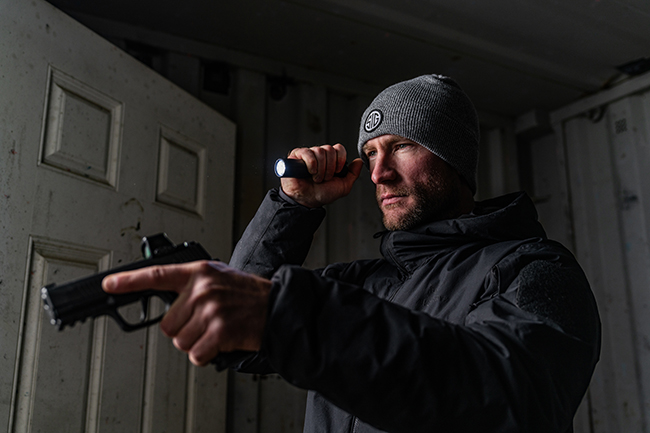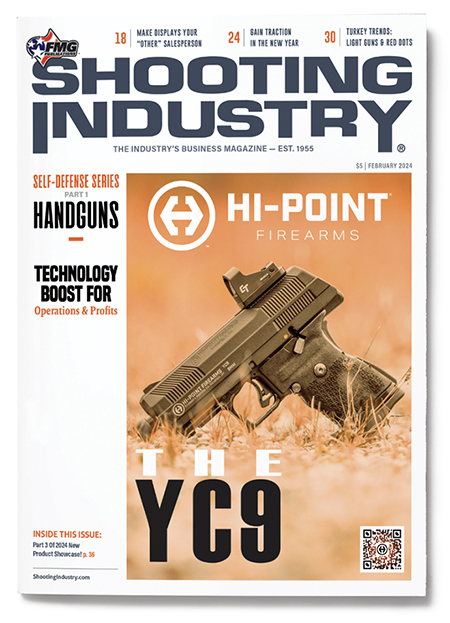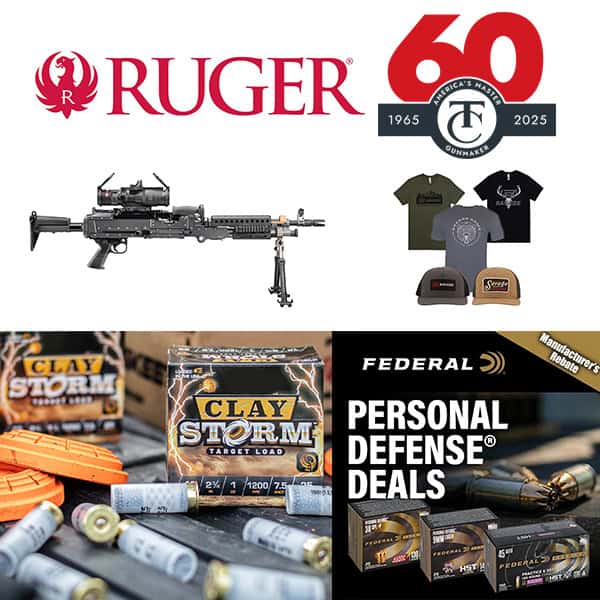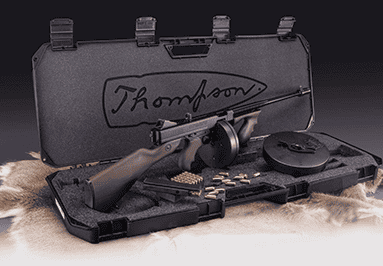In Focus:
Self-Defense Handguns
For most gun stores, there is no more important sales category than self-defense. Whether it’s handguns, rifles, shotguns or non-lethal options, these are the things that draw the largest and most diverse group of customers through the front door.
We are reminded of this every time a shockwave hits our communities. Political upheaval, social unrest, mass shootings and even seemingly unrelated world conflicts have the power to send nervous people flocking to their closest gun store.
This is the first of a three-part series exploring these self-defense sales. Later, we’ll examine long guns and non-lethal options. But any attempt to look at self-defense trends has to start with handguns.
Smaller carry guns and larger options for home defense — along with ammo and other accessories — are the bread and butter for retail gun stores like Black Wing Shooting Center in Delaware, Ohio. More often than not, the new and intermediate shooter is looking for a self-defense handgun of some sort.
“It helps drive our business,” said co-owner Mark Gore. “Those are also the people who make up a large portion of our member base. A lot of our ammo purchasers are people who are practicing for defensive reasons.”
The importance of the segment is amplified for shops near urban areas — particularly those with higher crime rates. Such is the case for Dunn’s Sporting Goods in Pevely, Mo., just south of St. Louis.
“Everything from concealed carry to guns for the home; it’s turned into a huge part of our business,” remarked Nathan Dunn, manager. “We’re 30 minutes from one of the worst cities in the United States, and most of our clients or customers work up there.”
There’s little reason to think this dynamic is changing anytime soon, if ever.
Mike Sfakianos, senior manager at Bill Jackson’s in Pinellas Park, Fla., sees it as a natural extension of a landscape where politics and turmoil fuel never-ending demand.
“It’s sad to say, but it’s what drives our business,” Sfakianos stated. “If the politics weren’t against guns, and if there wasn’t anything crazy going on in the world, we’d be dead. I mean, completely dead.”
What’s Selling?
It doesn’t take much imagination to guess which guns are favorites of self-defense customers. There’s a natural inclination toward smaller guns with above-average capacity. This means any of several micro compact 9mm options by SIG SAUER, Springfield Armory, Smith & Wesson and Ruger are quite popular. Each of these companies offer a model that effectively nullifies most of the size and capacity advantages .380 once offered for people looking for a smaller gun.
“Everybody’s always looking for a few things when choosing a carry gun,” Sfakianos relayed. “Weight and size are big factors. People want to have a full grip. And then for any kind of handgun, they always look to get as much capacity as possible.”
The popular Springfield Hellcat and other smaller guns have their fans, but the current leader in this race is the SIG P365 in its various configurations.
“It’s been a really hot seller and kind of hard to keep in stock,” confirmed Gore, in Ohio.
Smaller options are particularly attractive for people who only want to buy a single handgun. These guns might not be the preferred option for more experienced shooters, but they are appealing to someone who wants something for both the house and for easy carrying.
“A good chunk of people — even if they’re pretty confident they’re not going to carry often — still want the ability to do so,” Gore said. “We’re seeing a decent amount of people who will pick something that works for both.”
Smaller, however, is not always better.
Sfakianos has noticed the growing popularity of double-stack 1911s from companies like Staccato and Springfield Armory.
“Because they’re bigger and heavier, they’re more often used for the house, for vehicles and stuff where you’re not going to be carrying concealed,” he explained. “They’re wonderful to shoot at the range. The bigger and heavier the gun, the more comfortable it is to shoot.”
What About The Extras?
It’s tough to run a successful gun business just selling guns. Ammo and accessories represent an important potential revenue stream — and there are lots of opportunities when it comes to self-defense sales. This is particularly true when the customer is new to guns. They walk in the door without a single gun-related item to their name.
This creates opportunities for sales of ammunition (both range and defensive), spare magazines, holsters, speed loaders, weapon lights, bags, cleaning kits and ear/eye protection.
There’s also the surging popularity of red dots and guns that come from the factory ready to mount one. If customers don’t buy one with their new gun, they’ll at least consider it down the road.
For some of them, the added expense can be daunting, but there are things you can do to encourage sales, suggests Dunn, in Missouri. Help them see how the dot might look and work on their gun.
“We have them set up in the showcase, already on the gun,” Dunn noted. “People can see how they work. It’s the way they move.”
In Florida, Sfakianos also sees a growing number of customers interested in pistol upgrades. He sees it often with various GLOCKs and the SIG P320.
“We carry all sorts of different triggers, slides and barrels and all that kind of stuff,” he said.
Still, with the self-defense customers, those sales often come with a word of caution about the potential impact on the gun.
“These companies are guaranteeing their reliability,” Sfakianos informed. “But once you start changing stuff, you may have to tweak it and play with it in order to get it to run, right.”
“Gentle” Customer Service
In recent years, the industry has witnessed a massive influx of first-timers who know little about guns. Most of them are looking for something they can use for protection.
Guiding them through the process can be a challenge for salespeople who prefer working with more experienced customers with a solid understanding of guns. And many of these newer customers act and think differently from what might be considered the traditional gun store customer.
“People from all backgrounds and beliefs are coming in. We’re welcoming, friendly and not condescending,” said Gore in Ohio. “It’s not always easy. You can feel like you’re in a good place, and then something might happen, and you realize someone wasn’t on the same page in some area.”
Among the sales challenges are the novice customers with strong (and bad) ideas about self-defense strategies. An example might be someone who plans to put a cable lock on a self-defense gun and then store it in a safe until needed.
“Obviously, if it’s for defense, it’s not a great way to do it,” Gore reasoned. “We don’t say it’s a terrible idea. We’ll talk about how a lot of people handle that situation. In a gentle way, we’ll give them other options.”
It also helps when salespeople speak from experience about any gun a customer is considering.
“You get asked all the time if you’ve shot one,” shared Dunn, in Missouri. “A lot of times, it really sways the customer’s decision on which firearm he goes with.”
Sfakianos, in Florida, agrees.
“Whenever a new gun is launched, all of my reps usually come in to shoot it,” he said. “We’re blessed to have a range on the premises. So, they’ll go in and see how it feels in their hands and all that stuff.”
Marketing For Self-Defense
Interestingly, there doesn’t appear to be a significant need to market self-defense guns and products. This may be a case where they tend to sell themselves. Or it may be more accurate to say state, national and world events are all that’s needed to spur sales. Even Israel’s late-October invasion of the Gaza Strip made an impact.
“It gave us a little shot in the arm for a few weeks, but it’s back to normal now,” recalled Dunn, in Missouri.
There’s also the fact gun makers are busy promoting this line of business in popular gun magazines and elsewhere.
“We don’t market anything to a specific area, because the manufacturers can do it for us,” said Sfakianos.
Still, the sector does offer opportunities.
Ohio’s Black Wing takes into account customer interest through its series of training classes. They offer nearly a dozen different courses, including some geared toward concealed carry and others that focus on different skill levels.
“They’re not super expensive, but it’s a good way for average people who want to get some reps in a safe manner,” Gore specified. “They get to try some new and different things, versus what you can typically try in a static indoor range.”
Editor’s Note: This is the first installment in what will be a three-part series. Continuing in the March issue, Tim Barker interviews a panel of dealers who share tips for expanding self-defense long-gun sales. In April, this series will conclude with a look at non-lethal products.






